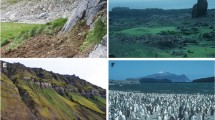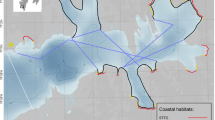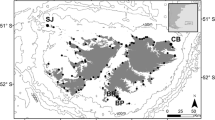Abstract
San Francisco Bay wetlands, seasonal and tidal marshes between the historic low and high tide lines, are now highly fragmented because of development during the past 150 years. Artificial salt pond systems in the Bay are hypersaline and typically support simple assemblages of algae and invertebrates. In order to establish the value of salt ponds for migratory waterbirds, we used datasets to conduct a meta-analysis of avian communities in the baylands and salt ponds of San Pablo Bay. Fifty-three species of waterbirds in the salt ponds represented six foraging guilds: surface feeders, shallow probers, deep probers, dabblers, diving benthivores and piscivores. The total number of species and the Shannon-Weiner diversity index was higher in baylands than in salt ponds during all four seasons. However, overall bird density (number/ha) was higher in salt ponds compared with baylands in the winter and spring, primarily because of large concentrations of benthivores. Cessation of salt production in 1993 and subsequent reduction in water depth resulted in a decline of some diving duck populations that used the salt ponds.
Similar content being viewed by others
References
Accurso, L. M., 1992. Distribution and abundance of wintering waterfowl on San Francisco Bay 1988-1990. Master's Thesis, Humboldt State Univ., Arcata, CA: 252 pp.
Anderson, W., 1970. A preliminary study of the relationship of saltponds and wildlife - South San Francisco Bay. Calif. Fish and Game 56: 240–252.
Bollman, F. H., P. K. Thelin & R. T. Forester, 1970. Bimonthly bird counts at selected observation points around San Francisco Bay, Febuary 1964 to January 1966. Calif. Fish and Game 56: 224–239.
Carpelan, L. H., 1957. Hydrobiology of the Alviso salt pond. Ecology 38: 382–385.
Davidson, N. C. & P. R. Evans, 1986. The role and potential of manmade and man-modified wetlands in enhancement of the survival of overwintering shorebirds. Colon. Waterbirds 9: 176–188.
Goals Project, 1999. Baylands ecosystem habitat goals. A report of habitat recommendations prepared by the San Francisco Bay Area Wetlands Ecosystem Goals Project. U.S. Environmental Protection Agency, San Francisco, CA and S. F. Bay Regional Water Quality Control Board, Oakland, CA: 209 pp.
Haas, J. E., 1994. Waterfowl use of grazed and ungrazed wetlands, Napa and Sonoma counties, California. Master's Thesis. Calif. State Univ. Sonoma. Rohnert Park, CA: 116 pp.
Harrington, B. & E. Perry, 1995. Important shorebird stating sites meeting Western Hemisphere Shorebird Reserve Network criteria in the United States. Unpubl. Rep. to the U.S. Fish and Wildlife Serv., Portland, OR: 121 pp.
Harvey, T. E., P. R. Kelly, R. W. Lowe & D. Fearn, 1988. The value of saltponds for waterbirds in San Francisco Bay and considerations for future management. Unpubl. Rep. at Wetlands' 88: Urban Wetlands and Riparian Habitat. Oakland, CA.
Harvey, T. E., K. J. Miller, R. L. Hothem, M. J. Rauzon, G. W. Page & R. A. Keck, 1992. Status and trends report on the wildlife of the San Francisco Bay estuary. EPA Coop. Agreement CE-009519–01–0 Final Report, U.S. Fish and Wildlife Service, Sacramento, CA: 283 pp.
Johnson, R. A. & D. W. Wichern, 1988. Applied multivariate statistical analysis, 2nd edn. Prentice Hall, Englewood Cliffs, NJ.
Josselyn, M., 1983. The ecology of San Francisco Bay tidal marshes: a community profile. FWS/OBS-83/23, U. S. Fish and Wildlife Service, Washington, DC.
Krebs, C. J., 1989. Ecological Methodology. Harper & Row, New York: 654 pp.
Lonzarich, D. G., 1988. Temporal and spatial variations in salt pond environments and implications for fish and invertebrates. Master's Thesis, San Jose State Univ., San Jose, CA: 81 pp.
Lonzarich, D. G. & J. J. Smith, 1997. Water chemistry and community structure of saline and hypersaline salt evaporation ponds in San Francisco Bay, California. Calif. Fish and Game 83: 89–104.
Martin, A. C., H. S. Zim & A. L. Nelson, 1951. American Wildlife and Plants: a Guide to Wildlife Food Habits. McGraw-Hill Book Co., New York, NY: 500 pp.
Miles, A. K., J. Y. Takekawa, D. H. Schoellhamer, C. T. Lu, W. G. Duffy & M. K. Saiki, 2000. Science support for wetland restoration in the Napa-Sonoma salt ponds, San Francisco Bay estuary, 1999 progress report. Unpubl. Prog. Rep., U.S. Geological Survey, Davis and Vallejo,CA: 57 pp.
Milliken, G. A. & D. E. Johnson, 1984. Analysis of Messy Data, Vol. 1: Designed Experiments. Van Nostrand Reinhold, New York.
Nichols, F. H., J. E. Cloern, S. N. Luoma & D. H. Peterson, 1986. The modification of an estuary. Science 231: 569–573.
Race, M. S., 1985. Critique of present wetlands mitigation policies in the United States based on an analysis of past restoration projects in San Francisco Bay. Environ. Manage. 9: 71–82.
Rappole, J. H. & R. M. DeGraaf. 1996. Research and effective management of neotropical migrant birds. Trans. n. am.Wildl. Natur. Resour. Conf. 61: 450–462.
SAS Institute, 1990. SAS Procedure Guide, Release 6.04 Edition. SAS Institute, Cary, NC.
Swarth, C. W., C. Akagi & P. Metropoulus, 1982. The distribution patterns and ecology of waterbirds using Coyote Hills salt ponds. U.S. Fish and Wildlife Service, San Francisco Bay National Wildlife Refuge, Newark, CA.
Terp, J. M., 1998. Habitat use patterns of wintering shorebirds: the role of salt evaporation ponds in south San Diego Bay. Master's Thesis, San Diego State Univ., San Diego: 79 pp.
Velasquez, C. R., 1993. The ecology and management of waterbirds at commercial saltpans in South Africa. Ph.D. Dissertation, Percy FitzPatrick Institute of African Ornithology, Univ. of Cape Town, South Africa: 248 pp.
Ver Planck, W. E., 1958. Salt in California. Calif. Div. Of Mines Bull. No. 175.
Warnock, S. E. & J. Y. Takekawa, 1995. Habitat preferences of wintering shorebirds in a temporally changing environment: western sandpipers in the San Francisco Bay estuary. Auk 112: 920–930.
Warnock, S. E. & J. Y. Takekawa, 1996. Wintering site fidelity and movement patterns of western sandpipers Calidris mauri in the San Francisco Bay estuary. Ibis 138: 160–167.
Author information
Authors and Affiliations
Rights and permissions
About this article
Cite this article
Takekawa, J.Y., Lu, C.T. & Pratt, R.T. Avian communities in baylands and artificial salt evaporation ponds of the San Francisco Bay estuary. Hydrobiologia 466, 317–328 (2001). https://doi.org/10.1023/A:1014546524957
Issue Date:
DOI: https://doi.org/10.1023/A:1014546524957




